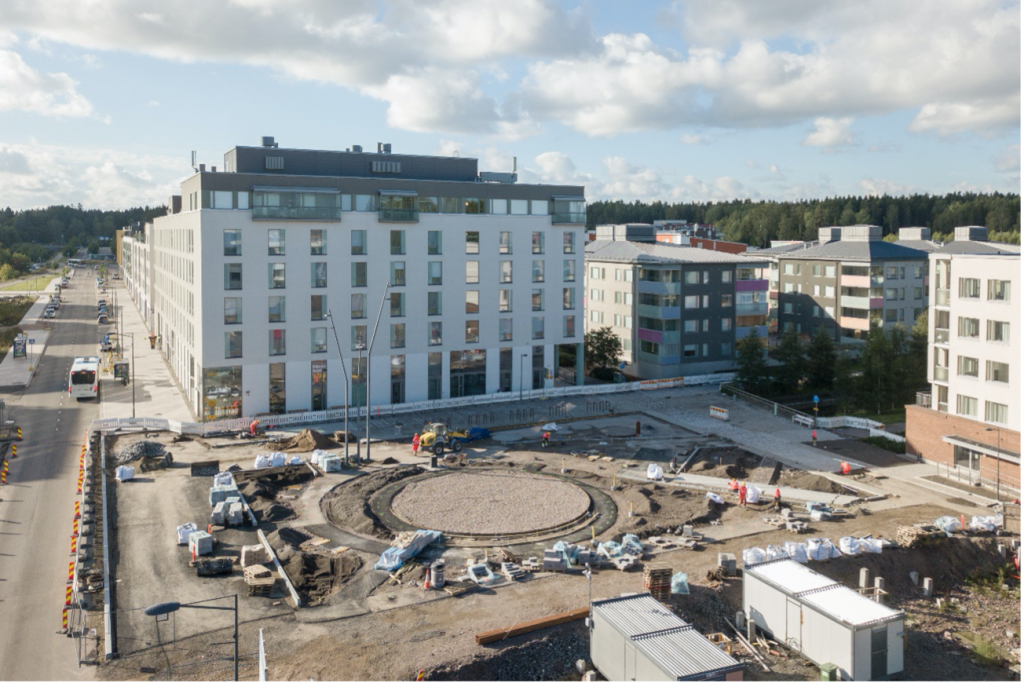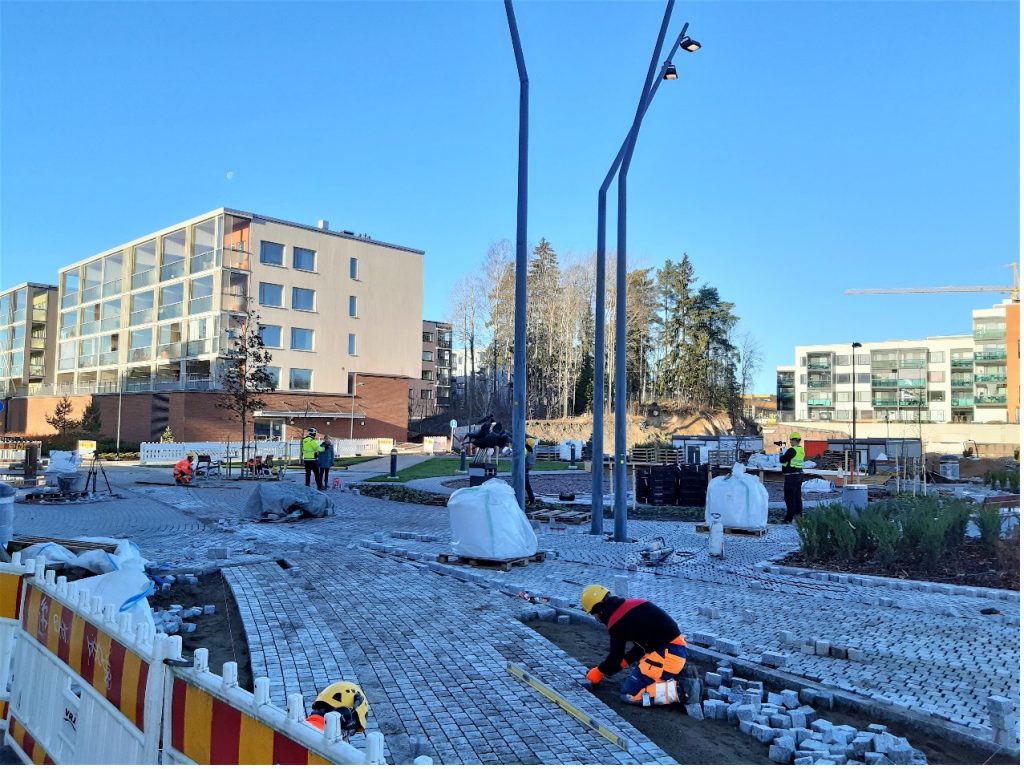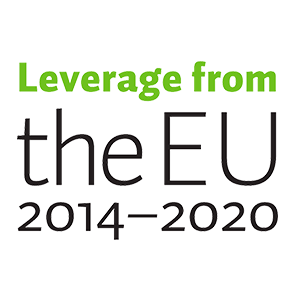
How can tenders promote emission reductions and resource wisdom?

Emission-free construction site: green public procurement
emission reductions, resource wisdom, logistics, heavy machinery and equipment, motive power types, zero-fossil, biofuels, contract procurement, environmental criteria, environmental values
The invitation to tender for the pilot construction site of Lukutori Square in Espoo included new and updated environmental criteria with the goal to reduce emissions from the construction site and transport. At the same time, the project team also piloted green procurement strategies by developing zero-emission practices used on the site and promoting resource wisdom through actions such as using Finnish paving stones.
- Successful dialogue with the market. The procurement tender criteria we used were realistic for the contractors and compliant with the Act on Public Procurement and Concession Contracts (Laki julkisista hankinnoista ja käyttöoikeussopimuksista, 1397/2016). We received a total of four offers that met the criteria. New and updated environmental criteria are being introduced to contracting tenders on all construction sites of the City of Espoo.
- The Green Deal. During the course of the pilot project, the Green Deal agreement for sustainable procurement and zero-emission construction sites in public procurement was prepared together with the Ministry of the Environment. The criteria for heavy machinery and equipment laid down in the Agreement were also piloted on the Lukutori site, which provided support and information needed to update the procurement process.
- Material production and transport are the key to the most substantial emission reductions. Lukutori Square was built using Finnish paving stones instead of stones imported from China, where the stones are usually sourced from. If stones from China had been used in the pilot project, its total emissions would have been over three times higher. This requires more resources for planning and contracting tenders, but in the long run, carbon-neutral and sustainable construction is not more expensive; on the contrary, it helps save money.
This solution is right for you if
- you are a public procurement expert;
- you are a contractor planning to purchase new machinery or equipment or to retrofit/convert your existing equipment to reduce emissions; or
- you work in urban planning and your goal is to achieve a carbon-neutral city.
Perustietoja
- Location of the industrial area: Lukutori Square, Suurpelto/Henttaa, Espoo
- Concept executed by: City of Espoo: Public Works Department and Environment Department.
- Time frame: 6/2020–12/2020.
- Project partners: VRJ Etelä-Suomi, Ramboll Finland, the Association of Finnish Technical Traders, Ramirent Finland, Loimaan Kivi, Kekkilä, Residents’ association of Suurpelto.
- The Lukutori project team also piloted the principles of the Green Deal Agreement for Sustainable Procurement and Zero-emission Construction Sites, which was made between the Ministry of the Environment, the cities of Helsinki, Vantaa and Turku and Senate Properties in the autumn of 2020.
- In public procurement, invitations to tender may not list ‘Made in Finland’ as a selection criterion, but environmental declarations, such as EPD, are allowed. Based on life cycle analysis, Environmental Product Declaration, or EPD, is a voluntary and standardised declaration that reliably presents the essential and verified information about the environmental impact of a manufactured product or product range in a comparable manner.

Procurement criteria promoting carbon neutrality and compliant with the Finnish procurement act were used in the pilot project on the emission-free Lukutori Square construction site
The site selected for the pilot project was the new central square and its adjacent streets in the district of Suurpelto in Espoo, as the scope of the contract was ideal for piloting new environmentally sound and sustainable procurement criteria. Stakeholders were invited to a market dialogue event where speakers talked about topics such as the construction industry’s climate targets and the availability of low-emission heavy machinery and equipment. After the event, contractors had the chance to participate in one-to-one discussions with the city. The purpose of the discussions was to analyse the contractors’ equipment fleet and their ability to make an offer based on the planned minimum criteria.
The invitation to tender was adjusted to include the minimum requirements for heavy machinery and heavy goods vehicles deemed realistic by the contractors and representatives of the heavy machinery industry, as well as emission-reducing construction site practices and the implementation of resource-wise strategies. The Lukutori Square pilot project challenged customers, contractors and other stakeholders to adopt new practices and strategies to build a better, carbon-neutral future. Successful criteria for contracting and equipment procurement and other emission-reducing principles and practices will be gradually introduced to all of Espoo’s construction sites, including building, infrastructure, renovation and demolition sites.

Adding new environmental minimum requirements to contracting tenders
The sustainable procurement process was adjusted by adding the requirement for using fossil-free biofuels, biogas or (green) electricity in the contractors’ heavy machinery and equipment. To help the contractor of the Lukutori site achieve the emission reduction target faster, the City of Espoo leased out a 4.2-tonne electric loader to be used on the site and granted the contractor a total maximum bonus of EUR 30,000.00 for using machinery and equipment powered by fossil-free fuels.
In the building contract programme of the pilot site, the contractor agreed to attend training on zero-emission construction sites to increase its understanding of how impactful and necessary the new operations and practices on the site can be. With more know-how, this also gives the contractor a competitive edge in future tenders.
The transport of paving materials was also taken into account in the minimum criteria for the procurement. The project team also piloted a real-time and site-specific solution supplied by Vediafi Oy that tracks and reports on emissions from transport. The pilot project’s costs do not increase when the procurement is evaluated over a longer period of time. More resources must be allocated to the planning and contracting tender stages of a construction project to ensure climate-positive results and quality requirements are achieved. The utilisation of digital solutions will need further research in future projects, as tracking the equipment and deliveries to and from the site requires more work and collecting information manually is practically impossible.


Principles of circular economy and resource wisdom put into practice on the Lukutori site thanks to EPD
To make sure the Lukutori site was resource-wise, the team used paving stones sourced from Finland instead of China, where the stones for infrastructure projects are usually imported from. This made it possible to reduce transportation emissions to the minimum. According to the Finnish public procurement act, requiring a product or material to be made in Finland is not allowed in the selection criteria, but the EPD value (Environmental Product Declaration) can now be used instead. Based on life cycle analysis, EPD is a voluntary and standardised declaration that reliably presents the essential and verified information about the environmental impact of a manufactured product or product range in a comparable manner. Using EPD as a selection criterion in public procurement is allowed.
The pilot site also applied principles of sustainable development laid down in the Espoo Story. VTT Technical Research Centre of Finland Ltd., an HNRY project partner, produced an emission assessment to determine how impactful the measures were.
Green Deal agreement for sustainable procurement and zero-emission construction sites in public procurement boosts development
The HNRY Project prepared the Green Deal agreement for sustainable procurement and zero-emission construction sites together with the Ministry of the Environment and the cities of Espoo, Helsinki, Vantaa and Turku. The Lukutori project team applied the criteria of the first target phase of the agreement where possible. The procurement criteria laid down in the Green Deal agreement takes into account aspects such as fossil-free motive power sources of heavy machinery and equipment, heavy goods vehicles and on-site electricity and heating as well as the development of lower-emission practices to be adopted on the site. Procurement practices in the public sector have the potential to have a huge impact on the amount of these emissions. At the same time, the public sector can pioneer the use of alternative motive power sources, boost demand and create the conditions for developing the market for low-emission solutions.
TAKE-HOME MESSAGES
- The importance of market dialogue: engage contractors and other stakeholders as early as when planning the contracting tender. Each site has its own clear / most significant possibilities for emission reduction, and these should be examined together with the stakeholders to find the most cost-effective and practical solutions.
- With the help of information and genuine dialogue, prevailing attitudes in the construction industry can be influenced to increase awareness of climate matters quickly enough.
- Carbon-neutral construction techniques and strategies are not more expensive when the costs are analysed over a longer period of time and when the goal is to apply the principles of sustainable construction in other areas as well.
- Contractors and other stakeholders are well-informed and ready to take action; those in charge of public procurement must not hesitate to develop the procurement process and to demand more in terms of taking the environment into account and applying the principles of circular economy.
“Thank you for supporting Finnish workmanship and the Finnish stone industry. As a geologist living in Espoo, I enjoy reading these articles.”
– A reader’s comment on a blog post about the pilot project.





 Video: Päästötön työmaa -pilottina Suurpellon Lukutori
Video: Päästötön työmaa -pilottina Suurpellon Lukutori